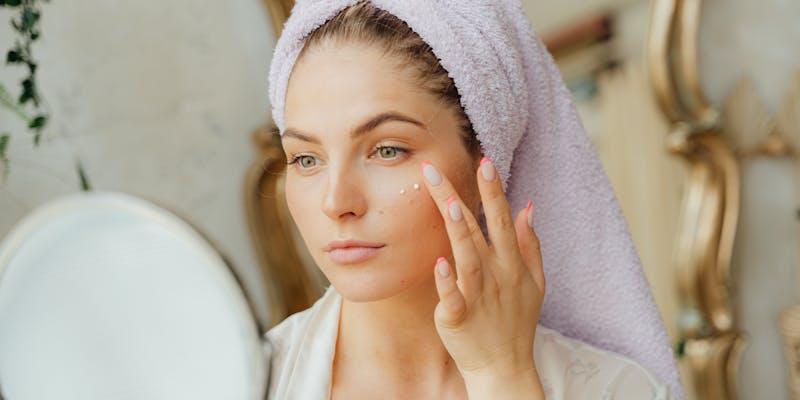How to Use Lactic Acid for Your Skin and Why It's Beneficial?
Mar 15, 2024 By Nancy Miller
Does it ever seem like your skin remains dry regardless of the amount of moisturizer you use? We understand your worries. In contrast to those with oilier skin types, individuals with dry skin often have this issue. Extreme weather, an inappropriate skincare regimen, hormonal changes, and even water temperatures are among the many potential causes of dry skin.
Consider using lactic acid as part of your skincare regimen if you suffer from persistently dry skin. You may discover lactic acid in several well-known skincare products, such as lactic acid body wash, a well-liked AHA recognized for its moisturizing and smoothing effects. Both professional chemical peels and over-the-counter chemical exfoliants include AHAs. Some lactic acid products may be safe for vegans since most of them are manufactured by a fermentation process utilizing cornstarch or beet sugar, as the Vegetarian Resource Group (VRG) pointed out. Milk and other dairy products may also ferment and release lactic acid. Keep reading for beginner-friendly information if you're unfamiliar with lactic acid and unsure where to begin!
Benefits of Lactic Acid

Anyone seeking these four outcomes will benefit greatly from lactic acid:
- Decreased texture
- Deep exfoliation
- Even skin tone
- Hydration
This exfoliating skincare component will leave your skin feeling smoother by removing dull, dead skin cells and encouraging normal cell turnover. Your skin may feel more hydrated and calmed as a result of using a product such as lactic acid body wash. A high cell turnover rate is one factor that makes skin seem radiant and healthy.
Fine wrinkles and uneven skin tone may both be reduced by lactic acid. Most wrinkles and fine lines occur on the outermost layer of skin. Thus, exfoliating may reveal younger, smoother skin. Regular application of lactic acid may lighten freckles, age spots, dark patches, and other moderate hyperpigmentation. Lactic acid cream exfoliates, moisturizes, and smooths skin. Lactic acid cream helps create skin hydration. Consider using lactic acid on dry skin.
Adding Lactic Acid to Your Skincare Routine

Do you wish to use nourishing lactic acid in your skincare? Lactic acid may be used in cleansers, serums, masks, and peels. Since skin sensitivity is key, read on for product recommendations. Weve discussed some ways you can include lactic acid in your skincare. However, be aware that its not recommended to use lactic acid in all steps and every product.
Cleanser
Any skincare routine starts with a mild cleanser. Wash your hands first since acne-causing bacteria spread via touch. Wash your face with lukewarm water after washing your hands. Too hot water may cause skin issues and hasten drying.
If you have sensitive skin, use a lactic acid cleanser. Choose a 5% lactic acid solution for gentler washing that won't bother sensitive skin. Serums and masks are supposed to stay on the face, whereas lactic acid cleansers should be washed off.
Serum
The serum is the next option. Serums, masks, peels, or a mix of the two are all available here. For optimal results when using a lactic acid serum, it is recommended to pat the serum over wet skin. To avoid skin irritation, a novice should gradually include lactic acid into their skincare regimen. Serums containing 10% lactic acid or less are a good place to start. A great method to ease your skin into using lactic acid is using one of these beginner-friendly serums.
Increase the lactic acid concentration in your skincare regimen as your skin adapts. To achieve this, try using a peel or a mask or search for serums with a greater lactic acid proportion. A wide range of lactic acid concentrations are used in peels and masks, from 10% to 30%. Beginning at a modest level and gradually increasing will set your skin up for success. Additionally, to avoid skin irritation, use the peels or masks no more often than every other day.
Moisturizer
Regular moisturizing is essential after using any chemical exfoliant. New skin, which is exposed when dead skin cells are removed, may dry out more quickly than older, more weathered skin. Lactic acid cream is your third choice for sustaining your newly exfoliated skin.
Be careful to work your moisturizer outward from the center of your face. As a bonus, it helps to seal the lactic acid against your skin, which enhances its absorption of the substance. Moisturizer makes skin more supple, so it consistently helps combat fine lines and wrinkles.
Skin type is the most significant aspect when selecting a moisturizer. Applying a skin-specific moisturizer may thoroughly hydrate dry skin. If your skin tends to produce excess oil, look for a lightweight and oil-free solution. Additionally, combining the two might work well for mixed skin types.
Sunscreen
Sunscreen use should always be the final step and option in the skincare regimen. Sunburn may happen to anyone's skin, but it's far more likely to happen to newly exfoliated skin. New skin lacks solar protection, making it more prone to harm.
Even with SPF 15, your skin is susceptible to the sun. Use a broad-spectrum sunscreen (SPF 30 or above) every day to keep your skin youthful and supple. To keep your skin adequately protected, reapply as instructed.
Final Thoughts
Lactic acid body wash could aggravate hypersensitive skin. See how your skin responds to a product with a low lactic acid concentration (5%) before moving on to a higher concentration. Stop using products, such as lactic acid cleansers or creams if they irritate your skin.
Anyone using topical retinoids such as Retin-A or Refissa should avoid skincare products containing lactic acid. Adding lactic acid to these products might make your skin more sensitive as they are already exfoliating.
Although lactic acid treatments are safe for daily use for some, others with more sensitive skin should limit their usage. Regarding the frequency of lactic acid administration, see your healthcare practitioner.







